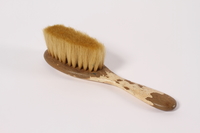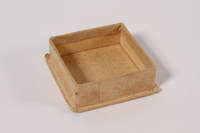Overview
- Brief Narrative
- Miniature pillow and wooden shoe in a small perfume box used by Edwin (Edik) Goldberg while confined to a bed with spinal tuberculosis in a labor camp in Siberia, from summer 1940 to August 1944 when he died at age 6. In 1939, Edik’s father, Emil, was called up by the Polish Army, leaving Edik and his mother, Elze, in Bielitz-Biala, Poland. Emil and Elze agreed to meet in Lvov (Lviv, Ukraine), if anything happened while he was gone. On September 1, 1939, Germany invaded Poland. On September 17, the Soviet Union annexed eastern Poland, including Lvov. At the end of 1939, Elze and Edik made their way to Lvov and were reunited with Emil. In June 1940, the family was transported to western Siberia. Two year old Edik and his parents, Emil and Elze, arrived at the Siberian camp in June 1940. Not long after their arrival, Edik contracted tuberculosis. No adequate treatments were available in the primitive conditions of the camp, where his father worked as a dentist and his mother as a nurse. On August 1, 1944, Edik died.The war ended in May 1945. In May 1946, Emil and Elze returned to Poland.
- Date
-
use:
approximately 1940 June-1944 August 01
- Geography
-
use:
Zapadno-Sibirskii krai (R.S.F.S.R.)
- Credit Line
- United States Holocaust Memorial Museum Collection, Gift of Leah Whiteman
- Markings
- b. top, printed, black ink : ПУАРА / ЕЕΛАЯ НОЧЬ.
b. front, printed, black ink : Ж / МАРИОМПШЕЯРОМ / СССР / ПАРФЮМ / Ф-КА / ΛЕНИНГРАА / ГΛАВПАРФЮМЕР
b. right side, printed, black ink : ЦЕНА / 1р.80Н.
b. back, printed, black ink : [illegible] - Contributor
-
Subject:
Edwin Goldberg
- Biography
-
Edwin (Edik) Goldberg was born on August 3, 1938, in Bielitz-Biala, Poland (Bielsko-Biala, Poland), to Emil and Elze Steuer Goldberg. Emil was born in 1911, in Niepolomice, Poland, to Moshe and Chava Goldberg. He had one younger brother, Hugo, and two sisters. Elze was born in 1911, in Bielitz-Biala, to Yitzkhak and Lote Koerbel Steuer. She had one older sister, Greta, and a brother, Avraham. Emil was a member of Maccabi Hatzair, a Zionist youth movement that fostered Jewish values, taught Hebrew, and encouraged physical activity. In 1933, Emil was drafted into the Polish Army. In 1936, he received a diploma from dental school. Elze ran a linen and embroidery shop that specialized in wedding dowry preparation. In 1937, Emil and Elze got married.
In 1939, Emil was called up by the Polish Army. Before he left, Emil and Elze agreed to meet in Lvov, Poland (Lviv, Ukraine), if anything happened. Elze hid one of his civilian suits with the military equipment he took with him. Not long after he left, he was made the head of a military unit. On September 1, 1939, Germany invaded Poland. On September 17, the Soviet Union occupied eastern Poland, including Lvov. Sometime in the second half of 1939, Elze decided to pack up all of Emil’s dental tools and their documents, and go to Lvov. She tried to convince her mother, Lote, and sister, Greta, to go with her, but they would not leave. Elze paid their neighbors to watch over them. Elze’s cousin, Ernst Koerbel, helped her and Edik cross the San River in a small boat. From there, Elze and Edik continued to Lvov, where they met her brother in law, Hugo Goldberg, his wife, Wanda, and their young son. A few days after Elze and Edik arrived, Hugo and his family disappeared.
German forces quickly overwhelmed Polish troops. Emil changed from his military uniform to the civilian suit that Elze had hidden in his things in order to blend in with the non-military population. Emil made his way to Lvov, where he was reunited with Elze and Edik. Soviet authorities moved the family around often, transporting them to Moscow and then back to the area around Lvov. In June 1940, the Goldbergs were transported to western Siberia to work at an industrial plant in Zapadno-Sibirskii krai. Elze worked as a nurse, and Emil, as a trained dentist, was made the head of the Health and Sanitation Department. He was responsible for managing the logistical, medicinal, nutritional, and sanitation needs of the factory’s workers. There were never enough supplies for everyone and the conditions in the factory were horrible. Shortly after arriving, two year old Edik contracted spinal tuberculosis. There was no proper treatment for the disease available at the factory. He was placed in a full body plaster cast and confined to a bed. Elze had to sell her jewelry and their personal belongings to get flour, bread, and other necessary items for the family.
In June 1941, Germany invaded the Soviet Union. Edik, almost 6, died on August 1, 1944. The war ended in May 1945. In May 1946, Emil and Elze returned to Poland. They stayed in Szczecin for two months, where their daughter Chava (Eva) was born on May 26. While there, they learned that Bielitz-Biala had been made into a ghetto by the Germans in the summer 1940. In June 1942, the ghetto was liquidated and Lote and Greta, Elze’s mother and sister, were transported to Auschwitz concentration camp and murdered. Her brother, Avraham, did survive. Emil’s sisters and their families had also gone to the Soviet Union and survived. His brother Hugo and his wife Wanda and their son were murdered in Lvov after disappearing in 1939. Emil and Elze decided that they did not want to return to Bielitz-Biala, and in July 1946, moved to Walbzych, Poland. Emil worked as a dentist at a public health center. Their second daughter, Lotka (Leah), was born there on October 15, 1947. In April 1957, the family immigrated to Israel and settled in Petach-Tikva. Emil, age 67, died on April 2, 1978. Elze, age 88, died on April 27, 1999.
Physical Details
- Language
- Russian
- Classification
-
Toys
- Category
-
Miniature objects
- Object Type
-
Miniature objects (lcsh)
- Physical Description
- a. Small square, light brown cardboard box base for lid (b.) with an extended lip on the bottom. The exterior is covered in brown paper that wraps over the top rim. A square piece of paper is glued to the underside.
b. Small square, light brown cardboard telescoping lid for box (a.) The exterior is covered with orange paper, printed with a black ink pattern of rectangles and squares and Cyrillic script. Adhered to the lid is yellow paper, printed with the image of a white columned archway in the General Staff and Ministries building in Leningrad.
c. Miniature, rectangular, firm dark blue velveteen cloth pillow with gold colored, twisted thread trim along the edges and a tassel in one corner. The stuffed pillow bulges outward on both sides. A clutch pin is inserted on the back.
d. Miniature, finished light brown wooden clog with an upward curving pointed toe, flat sides, and heel with a carved indentation for a foot hole. The shoe is decorated with a blue ink hand drawn diamond outline with pink painted loops and 3 pink dots. A pink line is painted around the foot indent, which is filled with the unraveled end of the pink thread that is inserted through the back of the heel. - Dimensions
- a: Height: 2.250 inches (5.715 cm) | Width: 2.250 inches (5.715 cm) | Depth: 1.000 inches (2.54 cm)
b: Height: 2.125 inches (5.398 cm) | Width: 2.125 inches (5.398 cm) | Depth: 1.125 inches (2.858 cm)
c: Height: 0.875 inches (2.223 cm) | Width: 1.250 inches (3.175 cm) | Depth: 0.500 inches (1.27 cm)
d: Height: 1.125 inches (2.858 cm) | Width: 0.500 inches (1.27 cm) | Depth: 0.250 inches (0.635 cm) - Materials
- a : cardboard, paper, adhesive
b : cardboard, paper, ink, adhesive
c : cloth, thread, metal
d : wood, paint, ink, thread
Rights & Restrictions
- Conditions on Access
- No restrictions on access
- Conditions on Use
- No restrictions on use
Keywords & Subjects
- Topical Term
- Forced labor--Soviet Union--Biography. Holocaust, Jewish (1939-1945)--Soviet Union--Personal narratives. Jewish children in the Holocaust--Soviet Union--Biography. Jews, Polish--Soviet Union--Biography. World War, 1939-1945--Conscript labor--Soviet Union--Personal narratives. World War, 1939-1945--Prisoners and prisons, Soviet.
Administrative Notes
- Legal Status
- Permanent Collection
- Provenance
- The playthings and box were donated to the United States Holocaust Memorial Museum in 2012 by Leah Whiteman, the sister of Edwin Goldberg.
- Funding Note
- The cataloging of this artifact has been supported by a grant from the Conference on Jewish Material Claims Against Germany.
- Record last modified:
- 2022-07-28 18:30:20
- This page:
- https://collections.ushmm.org/search/catalog/irn73617
Download & Licensing
In-Person Research
- By Appointment
- Request 21 Days in Advance of Visit
- Plan a Research Visit
- Request to See This Object
Contact Us
Also in Edwin Goldberg collection
The collection consists of a child’s hairbrush, handkerchiefs, and two small boxes with toys relating to the experiences of Edwin (Edik) Goldberg who, with his parents, Emil and Elze, fled Poland for the Soviet Union and were then imprisoned in a labor camp in Siberia during World War II.
Date: approximately 1940 June-1944 August 01

Child's hairbrush and plaid handkerchief used by a young Jewish Polish refugee
Object
Child’s hairbrush and striped handkerchief used by Edwin (Edik) Goldberg while confined to bed with spinal tuberculosis in a labor camp in Siberia, from summer 1940 to August 1944 when he died at age 6. In 1939, Edik’s father, Emil, was called up by the Polish Army, leaving Edik and his mother, Elze, in Bielitz-Biala, Poland. Emil and Elze agreed to meet in Lvov (Lviv, Ukraine), if anything happened while he was gone. On September 1, 1939, Germany invaded Poland. On September 17, the Soviet Union annexed eastern Poland, including Lvov. At the end of 1939, Elze and Edik made their way to Lvov and were reunited with Emil. In June 1940, the family was transported to western Siberia. Two year old Edik and his parents, Emil and Elze, arrived at the Siberian camp in June 1940. Not long after their arrival, Edik contracted tuberculosis. No adequate treatments were available in the primitive conditions of the camp, where his father worked as a dentist and his mother as a nurse. On August 1, 1944, Edik died.The war ended in May 1945. In May 1946, Emil and Elze returned to Poland.

Four child's playthings: a handkerchief, glass bear, and two seashells, and a box used by a young Jewish Polish refugee
Object
Small handkerchief, glass bear, and two seashells in a box used by Edwin (Edik) Goldberg while confined to a bed with spinal tuberculosis in a labor camp in Siberia, from summer 1940 to August 1944 when he died at age 6. In 1939, Edik’s father, Emil, was called up by the Polish Army, leaving Edik and his mother, Elze, in Bielitz-Biala, Poland. Emil and Elze agreed to meet in Lvov (Lviv, Ukraine), if anything happened while he was gone. On September 1, 1939, Germany invaded Poland. On September 17, the Soviet Union annexed eastern Poland, including Lvov. At the end of 1939, Elze and Edik made their way to Lvov and were reunited with Emil. In June 1940, the family was transported to western Siberia. Two year old Edik and his parents, Emil and Elze, arrived at the Siberian camp in June 1940. Not long after their arrival, Edik contracted tuberculosis. No adequate treatments were available in the primitive conditions of the camp, where his father worked as a dentist and his mother as a nurse. On August 1, 1944, Edik died.The war ended in May 1945. In May 1946, Emil and Elze returned to Poland.



